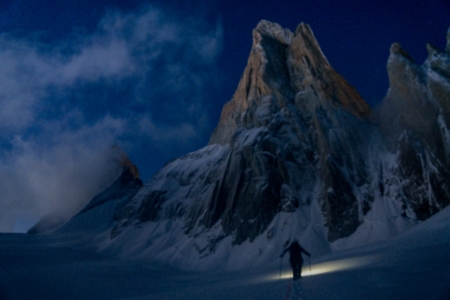SOLO
Colin Haley on the experience of soloing the Supercanaleta
A year and a half ago, I became the first person to climb the 11 most significant summits in the Chaltén group. However, I’ve always thought that these peak collections are kind of silly. I became the first person to do all 11 only because the Chaltén Massif is the mountain range that has most enchanted me and, in many seasons of climbing there, it was an inevitable desire to visit all the summits.
A collection much more meaningful to me, though, was the seven summits most prominent in the iconic view of the Chaltén skyline. By the end of my second trip to Patagonia in 2006, I had climbed all seven of these iconic spires, although mostly by their easiest routes. In 2011, I finished climbing all seven solo—a great journey, and a major learning experience.
Chaltén itself was by far the hardest and most memorable. It was January 2009, at the end of my fifth trip to Patagonia. My return flight was drawing near and I had set my sights on soloing Chaltén by the Supercanaleta, but good weather refused to come.
With just a few days left, I hiked into the Torre Valley. My desperation to go big had convinced me that a marginal improvement in the weather forecast was good enough to try. A meteogram wind forecast full of 9s and 10s is not really a wise time to head up Chaltén, but I was 24 and I wasn’t being wise.
I left my camp in the Torre Valley at 3 a.m. It was pitch dark, still windy and snowing lightly. My day started with 1,000 meters (3,281 feet) of moderate soloing up the Sitting Man Ridge. From the top of Sitting Man Ridge, I descended to the base of Chaltén’s west face and then began kicking steps up the lower portion of the Supercanaleta, still amid light snowfall.
The first 1,000 meters of the Supercanaleta is relatively easy—a mix of steep snow and easy ice climbing. Despite feeling apprehensive about the clouds and snowfall, I felt comfortable on the terrain and made steady progress. At the top of the snow and ice couloir the real difficulties began, including the accompanying psychological stress. After the first couple of difficult pitches, I came across the body of a Belgian climber who had died seven years earlier. His body hadn’t been seen since then and was mostly frozen into the ice of the couloir. Seeing a human body freaked me out, especially when I was so far away from any living person and because the Belgian climber had also been climbing solo. It was an extremely sobering reminder of the consequences.
To save weight, I brought just a single 60-meter rope, so every pitch took me farther away from a reasonable descent. I pinned my hopes on making it to the summit and descending the French route, which is shorter and has more existing rappel anchors. The higher I climbed, the more tired I became and the more stressed I felt.
As I gained height, the rock became more and more encrusted in rime ice. The rock shoes at the bottom of my backpack, which I had brought to use on the crux pitches, became dead weight. I ran out of food, then ran out of water. I used all sorts of different techniques: sometimes free-soloing, sometimes hauling my backpack up behind me, sometimes clipping myself to a couple camming devices and sometimes using the rope. The last pitch was one of the most difficult and the one place that I used traditional rope-soloing techniques—self-belaying up the pitch while placing protection, rappelling back down the pitch to remove the bottom anchor and then climbing up the pitch a second time. Alone near the top of Chaltén in an impending storm, climbing back and forth across this rising traverse and wearing every item of clothing I’d brought, I felt completely ridiculous.
I reached the summit of Chaltén at 8:20 p.m. Although I had visited many mountain ranges much more remote than the Chaltén Massif, I had never felt more distanced from other people, 3,000 meters (nearly 9,900 feet) below. I was already freezing cold and had just one rope to get off a huge, steep mountain, and it would soon be dark. Only equipped to make 30-meter rappels on the French route, I had to intentionally take two variations from the normal route to avoid 50-meter overhanging rappels. When I finally reached the glacier, I think it was around 2 in the morning. I was destroyed, physically and psychologically. Only then did I notice that one of my two ice axes was missing from my harness. I figured I had either absentmindedly left it stuck in the ice when making an abalokov anchor, or it had come unclipped and fallen off sometime during the nocturnal descent. (Seven years later, a couple climbers found it still stuck in the ice on one of the two variations I had made from the standard descent route.)
Finally free from terrain in which any fall would mean death, I began the long descent off the glacier and hiked out to town. I was so physically exhausted that I was perpetually cold, despite wearing all my clothing. Every half hour or so I would stop to sit on my backpack and fall asleep while sitting up. I would wake up shivering, get to my feet and stumble farther along. When I finally made it to town, I knew I had made it through the most intense experience of my life.
Just a couple days after soloing the Supercanaleta, I was sitting in a classroom in Seattle, surrounded by other university undergraduates. My classmate asked me how my winter break was. There was no point in trying to tell her about soloing the Supercanaleta. I knew that effectively conveying the intensity, stress, fear and elation of the experience was a hopeless task.
“My winter break was nice. How ‘bout you?”
“Oh my gosh,” she replied, “I went to this crazy New Year’s party! It was awesome.”

